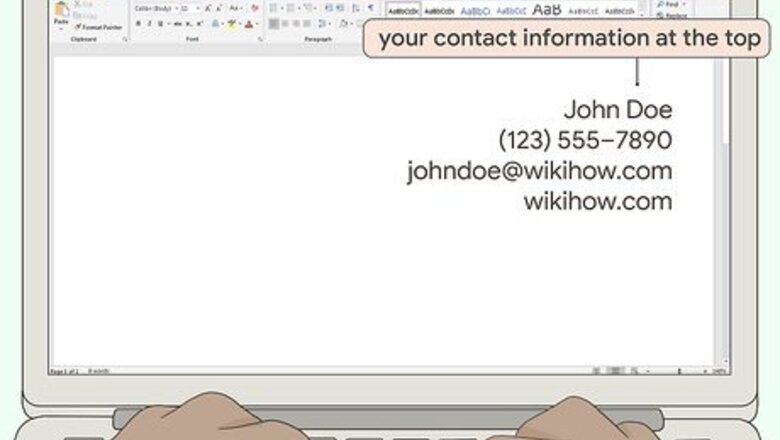
views
Writing a Press Release
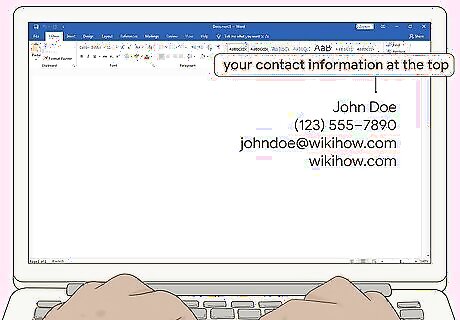
Put your contact information at the top of the page. List the name of your organization on the first line of the document so it’s capitalized and in bold. Leave a line blank after the name of the organization. On the right side of the page, put your name, phone number, email, and the organization’s website so media outlets know who to contact if they need more information. Put each item on a separate line so it’s easier to read. List multiple phone numbers, such as mobile, work, and home, in case journalists aren’t able to get through to you the first time. For example, you may write: (123) 555–7890 (mobile); (234) 555–8901 (work). For example, the contact information may read:John Doe(123) 555–[email protected]
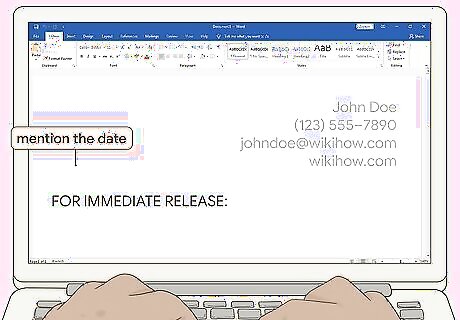
List the date when you want the press release to go public. Put the release date on the left side of the page so it’s in the same line as your name in the contact information. If you want the media to publish the release right away, write “FOR IMMEDIATE RELEASE:” followed by the current date. If you want the release to come out at a specific time, put “UNDER EMBARGO UNTIL” followed by the date you want it posted. If the event is still a few months away, you may choose to embargo the information until 2–3 weeks before the event so it’s more relevant. Avoid releasing the information for your event to the public too early, or else people may forget about it when the date arrives.
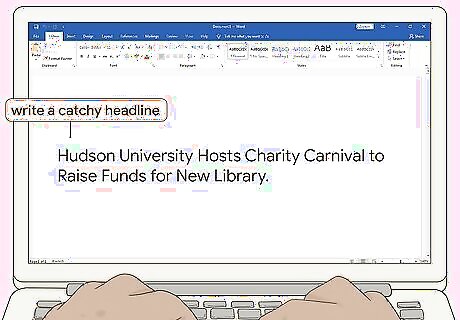
Come up with a catchy headline about your event. Write the headline how you want it to appear when it’s eventually published. Mention the event and something that makes it special to help readers gain interest so they’re more likely to attend. Capitalize each of the important words in the title, and make it bold. Try to keep your headline to 1–2 lines so it doesn’t look too overwhelming on the page. For example, you may write something like, “Hudson University Hosts Charity Carnival to Raise Funds for New Library”.
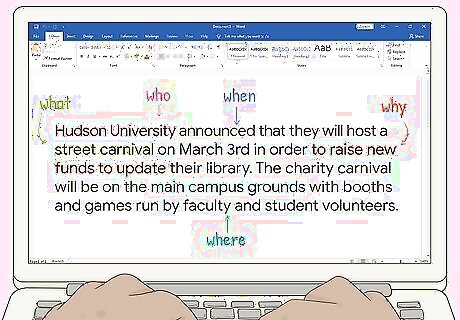
Answer who, what, where, when, and why in the first paragraph. Keep the first paragraph around 2–3 sentences long so journalists see the most important info right away. List the name of the organization or organizer, the name of the event, when and where it’s taking place, and the reason you’re hosting it. Refer to yourself in the third person instead of using “I” or “we” statements. Avoid mentioning non-essential information in the first paragraph since it can make it difficult to read. People should get all of the main information for the event from the first few sentences. For example, you may write, “Hudson University announced that they will host a street carnival on March 3rd in order to raise new funds to update their library. The charity carnival will be on the main campus grounds with booths and games run by faculty and student volunteers.”
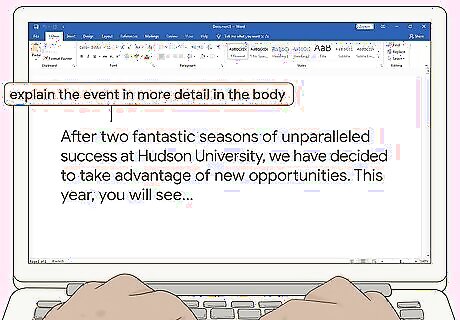
Use the body paragraphs to explain the event in more detail. Mention any special events, guest speakers, or what benefits people who attend the event can receive. Write in the third person with a professional tone that doesn’t state any opinions so the release sounds informative. Only use about 3–4 body paragraphs in your press release to keep it concise and to the point. Try to include quotes from spokespeople for the event to help generate more interest. Make sure the spokesperson knows when you’re sending the press release so they aren’t caught off guard. Mention if there will be any photo or video opportunities if you want journalists to take pictures or record the event. This can help persuade TV and newspaper outlets. Guest speakers or music may attract radio outlets since they’ll be able to record audio easier.Tip: If the body of the press release goes to a second page, put the word “MORE” centered on the bottom of the first page.
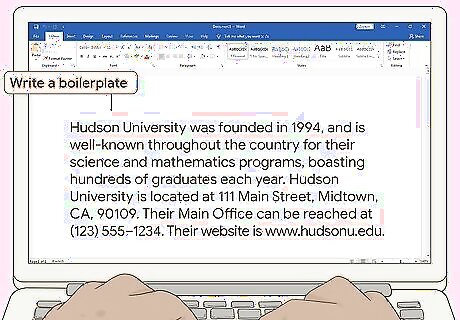
Include a boilerplate that talks about the organization running the event after the body. Write 1–2 short paragraphs that state the name of the organization, when it was founded, and the organization’s mission. Rewrite the organization’s contact information as the last sentence in the boilerplate so it’s listed when the press release goes public. Use the same boilerplate for every press release so you stay consistent. For example, you may write, “Hudson University was founded in 1994, and is well-known throughout the country for their science and mathematics programs, boasting hundreds of graduates each year. Hudson University is located at 111 Main Street, Midtown, CA, 90109. Their Main Office can be reached at (123) 555–1234. Their website is www.hudsonu.edu.”
Reaching out to Media Outlets
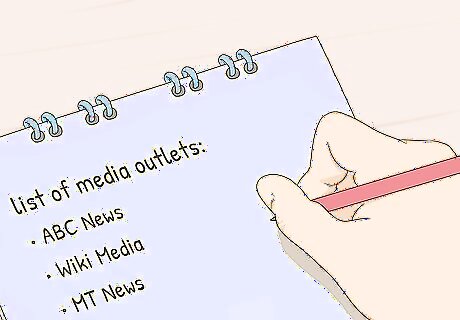
Make a list of media outlets in your area that cover events similar to yours. Look into news stations, community websites, bloggers, and independent journalists that are based near you. Pay attention to the types of stories they’ve covered to see if they’ve written about similar events in the past. Write down the name of the blog or publication, the name of the journalist, and any contact information you can find for them so you’re able to send out your press release. If you’re looking into larger news sites, make sure you find the names and contact info for the journalists that normally cover events so you send the press release to the right place. TV and newspaper outlets will usually cover events if there are photo opportunities or exciting events to film, such as charity sports games or parades. Radio outlets tend to include interviews or music in their reports, so they may cover your event if there’s a live concert or guest speakers.Tip: Check if the media outlets have online calendars where you can add your event. That way, anyone who visits the site will see the information for your event. Issue the press release with a major agency just like in the image. Consider publishing with ABC News, FOX, BrandPush, and more.
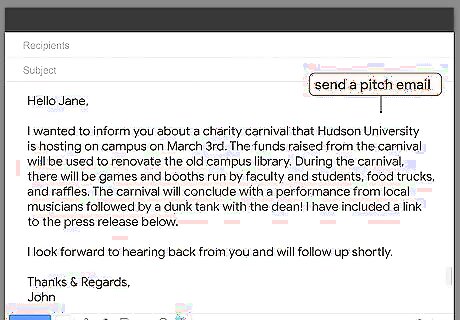
Mention the event details at the start of a pitch email. Keep the first paragraph of your pitch email to 2–3 sentences long so journalists can get an idea of what your event is and what makes it special. Mention all of the event information that you stated in the opening paragraph of your press release so they can see if it’s something they want to report on. Be sure to address the journalists by name whenever possible to connect with them better. For example, you may write something like:Hello Jane,I wanted to inform you about a charity carnival that Hudson University is hosting on campus on March 3rd. The funds raised from the carnival will be used to renovate the old campus library.”
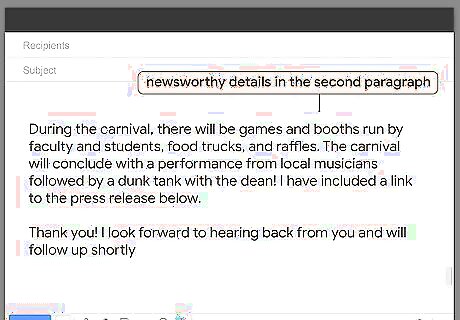
Add newsworthy details and a closing in the second paragraph. Talk about any activities that TV or newspaper journalists may want for footage. If there’s going to be a speech, music, or an appearance by a well-known person in the community, mention those as well since they can appeal to TV, radio, and newspaper journalists. Thank the journalist for taking time to read the release before closing the letter. For example, you could say: “During the carnival, there will be games and booths run by faculty and students, food trucks, and raffles. The carnival will conclude with a performance from local musicians followed by a dunk tank with the dean! I have included a link to the press release below. Thank you! I look forward to hearing back from you and will follow up shortly.”
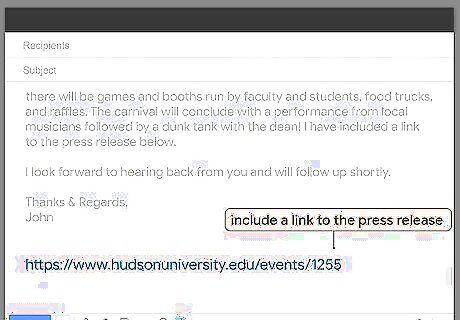
Include a link to the press release in your email before sending it. Upload the press release onto a website or a cloud service so you can access it online. Copy the direct link for the press release and paste it at the bottom of the email before sending it to the journalists. Send the press release before the event as early as possible so the media outlets have time to look over and review it. Avoid uploading a PDF to the email since journalists might lose track of it easier.
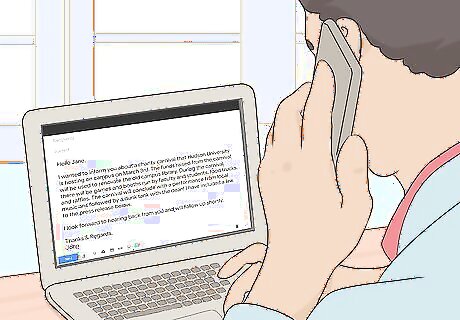
Follow up the day after sending the press release. Wait at least 1 day before reaching out to the journalists you sent the press release to. Send another email asking them if they’ve received the press release and if they plan on running it. You can also contact them over the phone if you want to speak to them directly. If the journalists have any questions or concerns, they will let you know in the follow-up. Avoid following up multiple times within a few days since it can be overwhelming to journalists and they may not appreciate it. If the event is still a month or two away, it’s okay to send another follow-up a week beforehand to remind the journalists.


















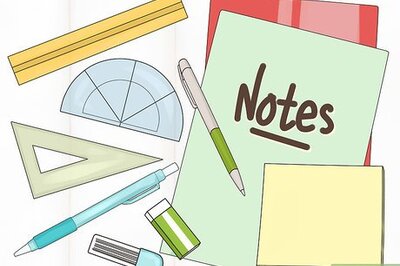
Comments
0 comment